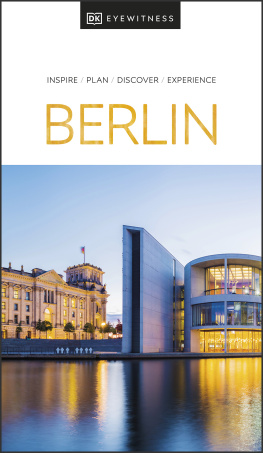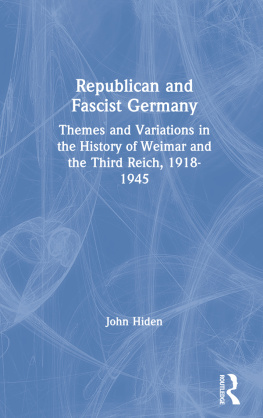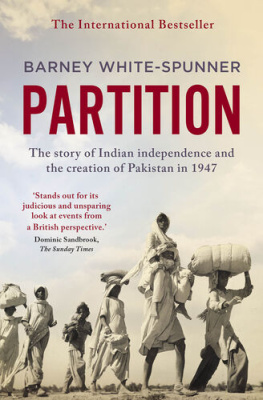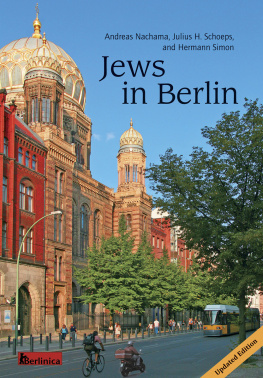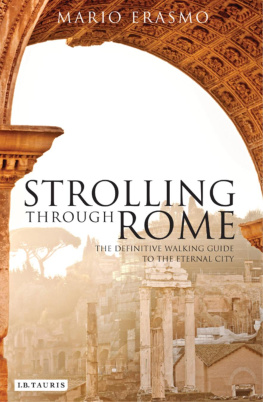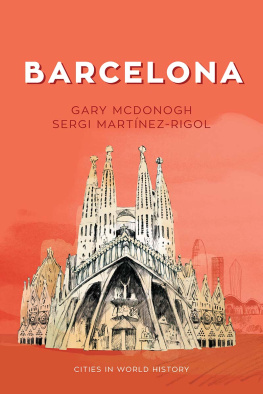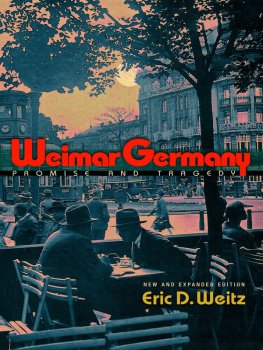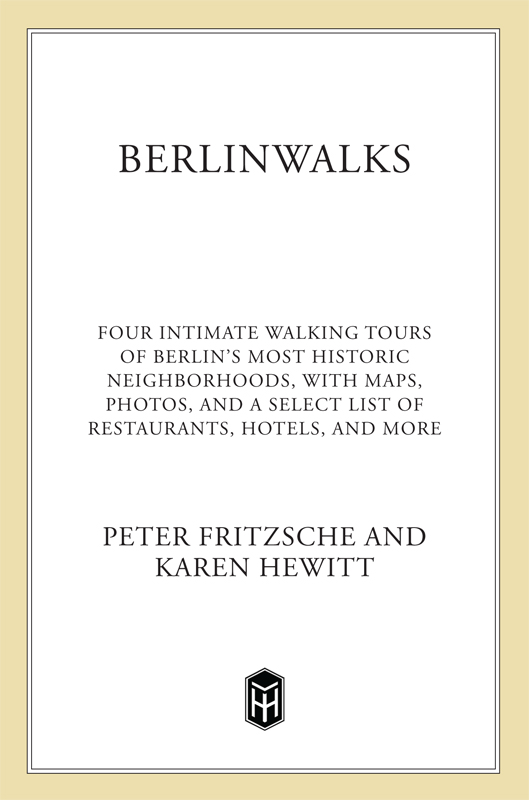

The author and publisher have provided this e-book to you for your personal use only. You may not make this e-book publicly available in any way. Copyright infringement is against the law. If you believe the copy of this e-book you are reading infringes on the authors copyright, please notify the publisher at: us.macmillanusa.com/piracy.
Contents
Walk 1
Berlin Mitte: The Historic City Center
Walk 2
The Scheunenviertel: The Jewish Quarter
Walk 3
Prenzlauer Berg: A Proletarian District
Walk 4
Kreuzberg: Experiments in Diversity
For Eric and Lauren
Acknowledgments
If acknowledgments were walks, we would start by thanking Nils Jacobsen, and Bruce Ostler at Fifi Oscard Agency. Then we would have to mention the obstacles on the waythose unexpected detours that add immeasurably to the journey: our son, Eric, who was born in Berlin, and our daughter, Lauren, who learned to walk (to the playground) in Berlin. To them this book is dedicated. We would also want to mention the throughway traffic, or perhaps we should say the encouraging pedestrians: Kate Doughty; Katja, Hellmut, and Sybille Fritzsche; Barbara Hewitt and John Basye; Tracy Egan; Betty Gold and Michael Kahn; and Cris Miller and Jerry Frakes. Thank you all for going the distance, sometimes under less than ideal conditions. For imagining images, special thanks to Thomas Fritzsche. And for being in Berlin, thank you to Carol Scherer and Faustyn Plitzko.

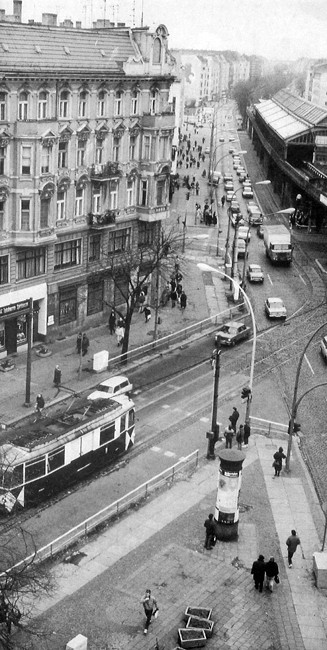
Introduction
Berlin is Europes most modern city and, paradoxically, always has been. Berlin is not simply the new capital of a reunified Germany that is rebuilding itself on a grand scale; Berlin is also a city that visionary architects and city planners, social revolutionaries and ruling kaisers have all tried to reshape. Over the course of the last three hundred years, there always has been a new Berlin in the making, and each version has left its mark on the city. As a result, Berlin is sheathed in layers of modern historyeach layer a chapter in the citys story of constant change. The four walks included in this book are designed to unwrap and reveal the traces of the citys breathtaking development.
The modern aspect of the city is all the more dominant because Berlin, unlike Vienna, Paris, or London, never was a Roman settlement, did not figure in the boisterous commercial activity of the Middle Ages, and never was the capital of a seafaring empire. This city came into its own only during the Industrial Revolution. As a relative newcomer, detractors denounced Berlin as Parvenupolis, an ugly duckling compared to the other great cities of Europe. But growing over the course of the nineteenth century from an insignificant provincial town into a tumultuous metropolis, Berlin quickly became the focus of startling innovation in the arts and industry. Every year thousands of newcomers arrived at the citys half-dozen train stations to make their fortunes and their reputations.
The new city breathed a rich atmosphere full of excitement, quick wit, and impertinence. One hundred years ago, visitors such as Mark Twain were remarking with astonishment on the citys relentless pace of transformation and comparing it to Chicago. By 1900 the extraordinary energy of Berlin made the city the foremost intellectual center in Germany. Poets, painters, and novelists all flocked to Berlin to experience life in the big city. Berlins lively theaters, cafes, and bawdy street life drew visitors from around the world. And while the imperial ambitions of the last kaiser, Wilhelm II, ended disastrously in World War I, Berlin continued to change in dramatic fashion. At one point in the 1920s, Berlins master planner, Martin Wagner, forecast the need to make over the central city every twenty-five years! As a result, the cityscape juxtaposes the avant-garde with older monumental constructions.
During the Weimar Republic (191933), Berlin was the celebrated site of artistic innovation and architectural Bauhaus experimentation. Berlin also witnessed much of the urban misery of the Great Depression, a period of political violence and economic hardship that ended with the Nazi seizure of power in 1933. Over the twelve-year course of the Third Reich, Hitlers architect, Albert Speer, began to rebuild Berlin in National Socialist fashion, an effort that left its marks on the city. The Nazis continue to haunt Berlin in other ways as well: Buildings in which concentration-camp victims were rounded up still stand throughout the city.
This ceaseless process of destruction and reconstruction, which took place between 1890 and 1940, is physically preserved in the saw-toothed profile of Berlin streets. The massive Allied bombing in 194345 only sharpened the effect. Buildings across Berlin still wear bullet holes and scars from artillery fire of street-to-street fighting that took place in April 1945. After the division of Germany in 1949, East and West Berlin developed their own highly distinctive modern styles. The attempt of the East Germans, in particular, to demolish the pre-Communist past and advertise their new Germany has left eastern Berlin with yet another layer of history. The Cold War and the construction of the Berlin Wall in 1961 refashioned not just the physical landscape but the intellectual and artistic landscape of the city in indelible ways. Now that Berlin will become the capital of a reunited and prosperous Germany, further dramatic changes to the cityscape are inevitable.
Berlin is fascinating precisely because it is a vast archeological site of the twentieth century. It is a unique place in which the remnants of its various pasts are exposed and juxtaposed. The four walks in this book explore Berlins history as a small medieval commercial town; as the capital of nineteenth-century Prussia; as the bustling center of an ambitious imperial Germany; as the modern dreamscape of the Weimar Republic; as the new Rome of the Third Reich; as the target of a fearsome Allied bombing; as the front line of the Cold War; as a divided city; and now, as the new capital of a reunited Germany.
Walk 1Berlin Mitte: The Historic City Centertakes you into Berlins historic city center and traditional seat of government, and to the site of two of Berlins most famous monuments: The Brandenburger Tor and the now dismantled Berlin Wall. Beginning at Potsdamer Platz and concluding at the historic gate, the walk takes you through Checkpoint Charlie, the eighteenth-century Gendarmenmarkt, past vacant government buildings of the former East German Republic, and along the historic boulevard Unter den Linden. Encompassing over three hundred years of historyfrom the Prussian kings through Hitlers Reich to the presentthis long walk is filled with the sweep of Germanys troubled history.
Walk 2The Scheunenviertel: The Jewish Quarteris a tour through Berlins former Jewish quarter and one of Berlins oldest districts. Hidden behind the wall, this neighborhood fell into decline during the Cold War years, but as home to many of Berlins poorest immigrants, it never was very prosperous to begin with. Along these once bustling streets, remnants of the sad history of Berlins Jewish population are revealed. Today the Scheunenviertel is reviving: Galleries, cafes, and refounded Jewish schools and synagogues have given new life to old stones.


